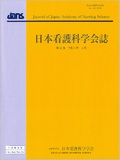Japanese
English
- 販売していません
- Abstract 文献概要
- 参考文献 Reference
要旨
目的:看護職が嚥下障害を臨床判断するための内容妥当性のある診断指標を明らかにし,major指標とminor指標も明らかにする.
方法:本研究はFehringのDCVモデルを使った.嚥下障害の看護診断に精通した専門家672人に質問紙調査を行った.診断指標78項目が,どの程度嚥下障害を表すか,5段階のリッカート尺度で評価をうけた.各診断指標で,回答を点数化してDCV値(平均値)を算出した.DCV値でmajor指標,minor指標,除外する指標に分けた.
結果:有効回答数は327人だった.major指標は11項目(食事中のチアノーゼ,嚥下後の呼吸切迫,嚥下テスト時の咽頭相の異常,嚥下後の湿性の呼吸音,むせる,食事中や食後に濁った声にかわる,喉頭挙上の不良,嚥下の遅延,嚥下前にむせる,嚥下後の嗽音の呼吸音,鼻への逆流)だった.minor指標は52項目,除外する指標は15項目だった.
結論:嚥下障害の看護診断に精通した専門家の意見に基づく,内容妥当性のある嚥下障害の診断指標が明らかとなった.
Objectives: The purpose of this study is to clarify defining characteristics with content validity for nurses to make clinical judgment of impaired swallowing, as well as the major and minor characteristics.
Methods: Fehring's DCV model was used in this study. We conducted a questionnaire survey on 672 experts of nursing diagnosis of impaired swallowing. The five-point Likert Scale was used to examine the extent to which 78 defining characteristics indicated impaired swallowing. For each defining characteristic, response was scored and DCV score (average) was calculated. Each defining characteristic was divided into major, minor, and exclusion characteristics according to DCV scores.
Results: Valid responses were obtained from 327 experts. There were 11 major characteristics (cyanosis during the meal, respiratory distress after swallowing, abnormal pharyngeal phase of swallow study, wet respiratory sounds after swallowing, choking, muddy sounds during or after a meal, inadequate laryngeal elevation, delayed swallowing, choking prior to swallowing, gargling breath sounds after swallowing, and nasal reflux). There were 52 minor characteristics and 15 exclusion characteristics.
Conclusions: We clarified defining characteristics of impaired swallowing with content validity based on opinions of experts familiar with nursing diagnosis of impaired swallowing.
Copyright © 2021, Japan Academy of Nursing Science. All rights reserved.


